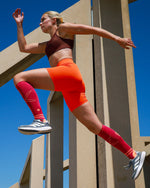
What is a calf strain?
A calf strain is a sudden rupture of the calf muscle, often caused by intense activities like sprinting or jumping. It can also happen during walking if the muscle gets overloaded unexpectedly. The pain is usually sharp and stabbing, and it might come with swelling and bruising.
Causes of a calf strain
A calf strain often happens due to sudden, intense strain on the muscle. Think about:
- Overuse during explosive efforts.
- Unexpected movements during your workout or daily activities.
- Skipping a proper warm-up before strenuous activities.
- Reduced flexibility in your feet, ankles, or knees.
- Previous calf injuries.
How to identify a calf strain
The symptoms of a calf strain are usually pretty clear:
- Sudden, sharp pain in your calf.
- Swelling and bruising at the tear site.
- Difficulty walking and pain when stretching or standing on your toes.
What to do for a calf strain
Cool your calf with ice
Apply an ice pack or a bag of ice cubes to your calf. This helps reduce pain and limit swelling. Cool for 10 minutes at a time, several times a day, especially within the first 24 hours.
Elevate your leg
Keep your leg raised on a pillow or another support while sitting or lying down. This helps to reduce swelling.
Use crutches if needed
If walking is too painful, crutches can help reduce the load on your calf.
Apply a compression bandage
A compression bandage can help control swelling. Make sure it's not too tight to avoid restricting blood flow.
Recovering from a calf strain
Recovery usually takes between 2 and 8 weeks, depending on the severity of the injury. Here are some tips to speed up your recovery:
Be careful when resuming activity
Gradually reintroduce physical activity. Start with light exercises and avoid intense loads until your calf is fully healed and pain-free. Listen to your body and stop immediately if you experience pain. Overdoing it can lead to a setback or worsen the injury.
Exercise
Stretching, strengthening, and functional exercises help rebuild your calf muscle.
Wear compression socks
Compression socks improve blood circulation, which helps reduce swelling and speeds up muscle recovery. They also stabilize your muscles, reducing the risk of further injuries.
A calf strain can be painful and frustrating, but with the right approach, you can significantly speed up recovery. Proper cooling, careful exercise, and wearing compression socks will help you get back on your feet quickly. If symptoms persist, consult a doctor or physiotherapist for personalized advice.







